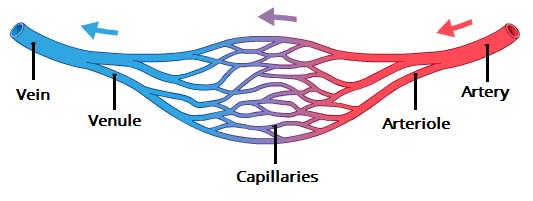Blood flow seems the opposite from river flow in that it goes from big to small. How do all the tiny little blood vessels make their way back into the return side of the blood stream?
Arteries turn into arterioles which turn into capillaries which turn into venules which turn into veins which return blood to the heart for pumping thru the lungs for oxygenation then back to the heart for pumping back to the rest of the body. The arterial side is high pressure, the venous side is low pressure, hence the flow.
Thanks for the diagrams, Qadgop.
HoneyBadger, I recently had an MRI with contract done, and was told that when the contrast was injected, I would feel a sensation of warmth as the contrast spread. What’s really cool is that, as I felt that warmth sensation spread I could visualize the circulatory system at work in ways that pictures cannot describe. It was a slow progression of warmth spreading outward from my heart. I could visualize the speed at which my blood travels through my body.
To anyone who will have that contrast injected, be prepared to have that sensation. It’s very interesting!
AKA “the rush”. ;-D
You really want to feel the rush, have a left ventriculogram performed during cardiac catheterization. That outdid all the previous rushes I’d had from CT or MRI contrast.
IV dilaudid (which I got for some very nastily fractured ribs) gives a completely different type of rush, and one that I don’t recommend unless it’s really REALLY necessary. For me it was just TOO good.
Also be ready to be VERY thirsty afterward.
I had a pelvic arteriogram once, and the contrast agent created a very painful burning situation every time they injected it. It might not have been the same agent as what you had, since your procedure involved an MRI and mine involved X-rays.
Great replies, very interesting
In addition to the higher to lower pressure thing, blood flow gets helped along by muscle contractions in your limbs, and the rhythmic squishing and relaxing that normal breathing creates in your chest and abdomen. Veins have little one-way valves to keep the flow from going backward.
The blood cells also line up single-file in the smallest capillaries. Most of them are extremely flexible.
Yeah–it’s a pretty neat sensation. Not the feeling you need to piss though when your that area warms up, though.
I understand that the return venous blood enters the right atrium and exits the right ventricle, then shoots through the pulmonary artery to the lungs. What I don’t get is why it’s necessary to have two chambers on each side. Is it for more efficient pumping? What about critters with two-chambered hearts, how does the heart pump blood out of the same chamber it’s entering? (I feel like I’m probably missing a major – and probably very blatant – step here…but luckily my heart has never relied on my intelligence to do its job.)
It’s more efficient. without the extra chambers, each beat would push blood both towards its intended target (lungs for R ventricle and rest of body for L ventricle) AND backwards from whence it came.
Now two chambers is still enough forward progress for many animals, but for the more metabolically active ones. And of course some creatures have two atria and only 1 ventricle, which is more efficient than just having two ventricles
I’d been warned about that, so availed myself of the nearest restroom just before going in. Definitely comforting to know that I was emptied out already. ![]()
I say this seriously and not as a joke- For all your blood and vein questions, I HIGHLY recommend the film Hemo. It is VERY goofy in spots. It is also profoundly educational.
I agree. I saw this film in 9th grade around 1971 or so, and it got me thinking about going into medicine.
If I look towards the sun with my eyes closed on a bright day, I can see little blobs moving along in single lines. I don’t know if I’m seeing capillaries in my eyelids, or some deeper level of the eyeball, but it always amazed me that I could see single cells without microscopes or any other technology.
(Possibly this is aided by the fact that I’ve been extremely near-sighted even before school age.)
I watched it, it was good.
Which is why sickle cell anemia is painful.
Learning here that they line up in single file, and flexibility is key,… now I understand why SCA is painful. Thanks for this discussion.
The venous return side of the system has one way valves, muscle contractions and breathing provide additional pumping force.

